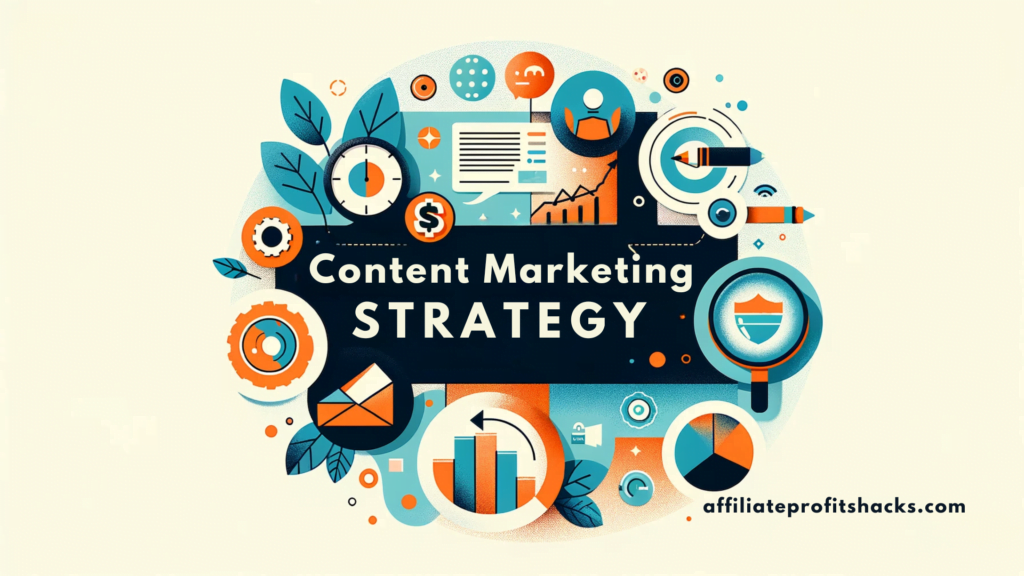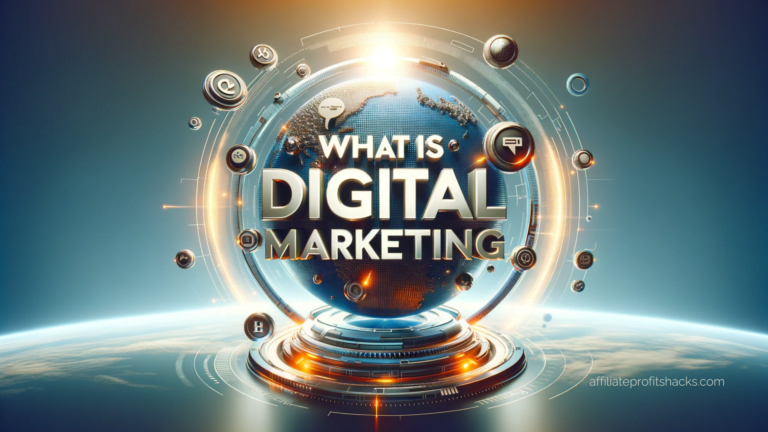Content Marketing Strategy: The Future of Digital Engagement
Welcome and thank you for checking out my article about creating engaging content for your marketing.
In the dynamic world of digital marketing, content remains king. As we move further into 2024, understanding and implementing effective content marketing strategies have become crucial for businesses seeking to stand out in a crowded online landscape. From the early days of simple blog posts to today’s complex digital ecosystems, content marketing has evolved dramatically.
Discover the Top Proven Method to Earn Money Online — Get Instant Access Now!

This evolution isn’t just about keeping up with the latest trends; it’s about connecting with audiences in meaningful ways, leveraging technology to enhance creativity, and measuring success to continuously improve engagement.
In “Content Marketing Strategy: The Future of Digital Engagement,” we will dive into the core aspects of modern content marketing. We’ll explore how it has changed over the years and what current trends are shaping its future. The article will provide insights into the integration of AI and automation in content creation, the importance of personalization, the growing role of multimedia and interactive content, and the critical aspect of analyzing performance through metrics.
This journey through the landscape of content marketing is designed not just to inform, but to empower. Whether you’re a seasoned marketer or a business owner looking to expand your digital footprint, these insights will equip you with the knowledge and tools to craft a content strategy that resonates with your audience and drives success.
Evolution and Trends in Content Marketing
Content marketing has come a long way from its humble beginnings. Initially, it was all about writing articles and blogs to attract attention online. But now, it’s a vast field that includes various forms of digital content, such as videos, podcasts, infographics, and more. This evolution is not just about the formats we use; it’s about how we connect with our audience in more engaging and meaningful ways.
The Journey of Content Marketing
The journey of content marketing began with simple blog posts and articles. In the early days of the internet, content was primarily text-based and focused on keywords to improve search engine rankings. However, as digital technology advanced, so did the possibilities for content. The introduction of social media platforms gave rise to new forms of content like posts, tweets, and stories. These platforms allow businesses to engage with their audience in real-time, making content marketing more dynamic and interactive.
Current Trends Shaping Content Marketing
As we step into 2024, several key trends are shaping the future of content marketing. First, there’s a growing emphasis on quality over quantity. With the vast amount of content available online, audiences are becoming more selective. They prefer content that is not only informative but also engaging and relevant to their interests.
Another significant trend is the use of AI and machine learning in content creation and distribution. AI tools are now capable of analyzing user data to understand preferences and behaviors, allowing marketers to create more targeted and personalized content. This technology also helps in automating routine tasks, such as content scheduling and performance analysis, making the process more efficient.
Interactive content is also on the rise. Interactive quizzes, polls, and infographics engage the audience more effectively, encouraging them to spend more time with the content and share it with others. This interactivity enhances user experience and provides valuable feedback and data to content creators.
Finally, the integration of content marketing with other digital marketing strategies is becoming more prevalent. Content is no longer a standalone element; it’s part of a larger digital marketing ecosystem that includes SEO, social media marketing, email marketing, and more. This integrated approach ensures a consistent message across all channels and maximizes the impact of marketing efforts.
Embracing AI and Automation for Content
The integration of artificial intelligence (AI) and automation in content marketing represents a significant shift in how we create and distribute content. These technologies are transforming traditional content strategies, making them more efficient and impactful.
The Impact of AI on Content Creation
AI’s role in content creation is becoming increasingly influential. AI-powered tools can analyze large datasets to identify trends and preferences, helping marketers understand what content resonates with their audience. Moreover, AI can assist in generating content ideas, creating drafts, and even suggesting improvements to enhance readability and engagement.
One of the most notable applications of AI in content marketing is in personalization. AI algorithms can sift through user data to deliver highly personalized content experiences. This could mean recommending articles based on a user’s reading history or tailoring email marketing messages to individual preferences. This level of customization is not just about delivering content; it’s about creating a unique experience for each user.
Implementing Automation Tools Effectively
Alongside AI, automation plays a crucial role in streamlining content marketing processes. Automation tools can handle repetitive tasks like scheduling posts, sending emails, and analyzing data. This frees up marketers to focus on more creative and strategic aspects of their jobs.
However, effective implementation of automation requires a balance. It’s essential to ensure that automated content still feels personal and authentic. The goal is to use automation to enhance human creativity, not replace it. For instance, while automated emails can reach a large audience efficiently, they should still feel personalized and relevant to the recipient.
Automation also extends to content distribution. Tools can automatically share content across multiple platforms at optimal times, increasing reach and engagement. They can also track user interactions, providing valuable insights that help refine future content strategies.
In summary, embracing AI and automation in content marketing is about leveraging technology to create more personalized, engaging, and efficient content strategies. As these technologies continue to evolve, they will undoubtedly play an even more significant role in shaping the future of content marketing.
Mastering Personalization in Content
Personalization has become a cornerstone of effective content marketing. In a digital world overflowing with information, personalized content helps businesses stand out and connect more deeply with their audience. It’s about delivering the right message to the right person at the right time.
Discover the Top Proven Method to Earn Money Online — Get Instant Access Now!
The Power of Tailored Content
Personalized content is more than just inserting a customer’s name in an email. It’s about creating content that resonates with the individual’s interests, needs, and preferences. This level of personalization can significantly enhance user engagement and loyalty. For instance, a fitness brand might share different content with someone who’s a long-distance runner versus someone interested in yoga. By catering to their specific interests, the brand increases the relevance of its content and builds a stronger, more personal connection with its audience.
Data plays a crucial role in personalization. By analyzing data from various sources like website interactions, purchase history, and social media engagement, marketers can gain insights into their audience’s preferences. This data-driven approach allows for the creation of segmented and targeted content, ensuring that each piece of content is tailored to the interests of a specific group.
Strategies for Personalization
Developing a successful personalization strategy involves several key elements. First, it’s important to collect and analyze the right data. This might include tracking user behavior on your website, monitoring engagement on social media, and gathering feedback through surveys.
Once you have the data, segmenting your audience is the next step. Segmentation involves dividing your audience into groups based on shared characteristics or behaviors. This enables you to tailor your content to each group’s specific needs and preferences.
Creating personalized content also means being dynamic and responsive. It involves continuously testing and adjusting your content based on user feedback and changing preferences. For example, if a certain type of content receives more engagement, it’s a signal to produce more of that content.
Finally, technology plays a key role in personalization. Using content management systems (CMS) and marketing automation tools such as MyGeniusLeads, you can automate the delivery of personalized content. These tools can help in scheduling content delivery based on user behavior, ensuring that each user receives content that’s most relevant to them at the right time.
In conclusion, mastering personalization in content marketing isn’t just a trend; it’s a fundamental shift in how we approach content creation. It’s about understanding and addressing the unique needs and interests of your audience, leading to more meaningful engagement and stronger customer relationships.
Exploring Multimedia and Interactive Content
In the ever-evolving landscape of content marketing, multimedia and interactive content have emerged as powerful tools. These forms of content are not just about conveying information; they are about creating an immersive and engaging experience for the audience.
The Rise of Visual and Interactive Elements
The human brain processes visuals much faster than text, which is why multimedia content like videos, images, and infographics have become so popular. They capture attention, improve understanding, and are more likely to be shared. Videos, for example, can convey complex information in an easily digestible format, making them ideal for explaining products or services.
Interactive content takes engagement a step further. Quizzes, polls, interactive infographics, and augmented reality (AR) experiences invite the audience to participate rather than just consume. This interaction increases engagement and provides valuable feedback and data about the audience’s preferences and behaviors.
Best Practices for Multimedia Content
Creating effective multimedia and interactive content involves several best practices. First, it’s important to ensure that the content is relevant and adds value to the audience. For instance, a how-to video should be concise, clear, and directly address the viewer’s needs.
Accessibility is also key. Multimedia content should be easy to access and view on various devices, including smartphones and tablets. This means optimizing file sizes for quick loading and ensuring compatibility across different platforms.
Storytelling is another crucial element. Whether it’s a video, infographic, or interactive tool, the content should tell a compelling story. A good story captures attention, evokes emotions, and is memorable.
Finally, integrating multimedia content with other marketing strategies is essential. For example, a video on your website can be promoted through social media, included in an email campaign, or used in a presentation. This integrated approach helps maximize the reach and impact of your content.
In summary, multimedia and interactive content are not just trends in content marketing; they are essentials. By leveraging these tools, marketers can create more engaging, memorable, and effective content that resonates with their audience.
Analyzing Content Performance
In the realm of content marketing, creating outstanding content is only part of the equation. The other critical aspect is analyzing its performance. Understanding how your content performs helps you refine your strategies and make informed decisions for future campaigns.
Essential Metrics for Success
To effectively analyze content performance, you need to focus on certain key metrics. These include engagement metrics like page views, time spent on page, likes, shares, and comments. These indicators provide insight into how interesting and relevant your content is to your audience.
Conversion rates are also crucial. They measure how effectively your content persuades your audience to take a desired action, like signing up for a newsletter or making a purchase. High conversion rates typically indicate that your content is not only engaging but also effective in driving business goals.
Another important metric is the bounce rate, which shows the percentage of visitors who leave your site after viewing only one page. A high bounce rate could suggest that your content is not meeting the expectations of your visitors or that your website is difficult to navigate.
Leveraging Analytics to Improve Strategies
To analyze these metrics, leveraging analytics tools is essential. Tools like Google Analytics provide a wealth of data about your content’s performance. They can help you track user behavior, identify which content is most effective, and understand how users are interacting with your site.
Using this data, you can identify trends and patterns. For instance, if certain types of content consistently perform well, it may be beneficial to focus on creating more of that content. Conversely, if some content has low engagement, you might need to revise your approach or experiment with different formats.
Discover the Top Proven Method to Earn Money Online — Get Instant Access Now!
It’s also important to regularly review and adjust your content strategy based on analytics. This might mean changing your content calendar, experimenting with new types of content, or adjusting your SEO tactics. The key is to be flexible and responsive to what the data tells you.
In conclusion, analyzing content performance is a vital step in content marketing. It allows you to measure the effectiveness of your content, understand your audience better, and continuously improve your strategies. By paying close attention to metrics and leveraging analytics, you can ensure that your content marketing efforts are successful and aligned with your business objectives.
Integrating Content Marketing into the Broader Digital Strategy
In today’s digital landscape, content marketing cannot exist in isolation. Its true potential is realized when it’s seamlessly integrated into a broader digital marketing strategy. This integration ensures a unified message across all platforms and maximizes the impact of each marketing effort.
The Synergy Between Content Marketing and Other Digital Strategies
Content marketing works best when it complements other digital marketing initiatives such as social media marketing, search engine optimization (SEO), email marketing, and pay-per-click (PPC) advertising. For instance, the content created for blogs or websites can be promoted through social media channels, enhancing reach and engagement. Similarly, SEO strategies can be tailored to enhance the visibility of your content, ensuring it reaches the target audience effectively.
Email marketing campaigns can be significantly more effective when they include well-crafted, relevant content that adds value to the recipient. This could be in the form of newsletters, exclusive articles, or early access to new content. The personalized nature of email also offers a unique opportunity to deliver tailored content that resonates with each segment of your audience.
PPC campaigns can also benefit from strong content marketing. By linking ads to high-quality, relevant content pages, you can improve the user experience and increase the likelihood of conversion. This approach ensures that your paid efforts are supported by solid content that engages and informs your audience.
Implementing a Holistic Approach
To effectively integrate content marketing into your broader digital strategy, a holistic approach is necessary. This involves planning your content with other marketing activities to ensure consistency in messaging and timing. It’s about understanding how different channels and tactics can complement each other and working towards a unified goal.
Regular communication and coordination between different marketing teams are crucial. This ensures that everyone is on the same page and that the content aligns with overall marketing objectives. It also allows for the sharing of insights and data, which can inform and improve the overall strategy.
In conclusion, integrating content marketing into the broader digital strategy is not just beneficial; it’s essential in today’s interconnected digital world. By creating a cohesive and comprehensive approach, businesses can ensure that their marketing efforts are more effective, consistent, and impactful.
Conclusion
As we’ve explored in “Content Marketing Strategy: The Future of Digital Engagement,” the world of content marketing is constantly evolving, driven by technological advancements and changing consumer behaviors. From the early days of simple blog posts to the current era of AI-powered personalization and interactive multimedia content, the journey of content marketing reflects a broader shift in how businesses connect with their audiences.
The key takeaways from this exploration are clear: Embrace the ongoing evolution and trends in content marketing, leverage the power of AI and automation for more efficient and targeted content creation. Master the art of personalization to forge deeper connections with your audience, utilize multimedia and interactive content to engage and captivate, and diligently analyze content performance to continuously refine and enhance your strategies.
As we look to the future, these strategies will not only help businesses stand out in an increasingly crowded digital space but also build lasting relationships with their audience. The landscape of content marketing may continue to change, but the core objective remains the same: to deliver valuable, relevant, and engaging content that resonates with your audience.
Discover the Top Proven Method to Earn Money Online — Get Instant Access Now!
In a world where content is ubiquitous, the brands that succeed will be those that understand and adapt to these changes, constantly striving to connect with their audience in more meaningful ways. The future of digital engagement lies in innovative, informed, and dynamic content marketing strategies. Embrace these principles, and your brand will navigate the digital landscape of today and thrive in the unknown terrains of tomorrow.
This related article about the Critical Role of Content Marketing in Affiliate Marketing may be of interest to you.
Thank you for taking the time to read my article “Content Marketing Strategy: The Future of Digital Engagement”. I hope that you found value in it!







